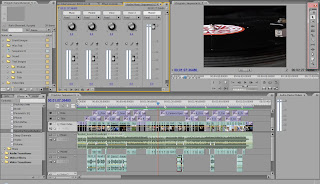Wednesday, October 07, 2009
My Research Conclusion - In Practise
Ironically I have come across the following, which is an implementation of my conclusion:
11. VW Mentorship Opportunities
Do you want to make a difference and raise the aspirations of young people?
The Visable Women campaign aims to allow students to be the driving force in challenging the underrepresentation of women in certain industries and senior management positions. They want to create a female/student graduate network whose gifts and talents are discovered and nurtured so that they are prepared to be more than just employees but inspirational leaders in their workplace, local community and the wider society. One of the avenues through which they do this is via implementing an informal mentorship scheme for dynamic students who want to learn and develop with your help. This is a great way to give back and help a less experienced person hoping to enter a similar career field at the same time.
The following link has more information: http://www.womenintechnology.co.uk/october-2009-update#11
It is quite interesting as well as encouraging to learn that my research project is being practised by other organisations in the UK.
Wednesday, May 20, 2009
PRP: Artefact 6 - The Idea
Idea:
- to set up a pilot mentoring scheme with existing multimedia students
- begin artefact early - tested over time
- Hold mentor meetings provide support where needed
- Provide training where necessary
Aim:
- to test and evaluate the effectiveness of a woman mentor studying the same subject area
- to evaluate how a mentor scheme for women multimedia students can encourage a positive transition into the working environment
- to explore the possibilities of expanding the mentor scheme into a more formal activity / group
PRP: Artefact 5 - The Idea
Idea:
- To create an environment involving women and men working on technology together
- Final year fashions show (roles - camera operator, live video feed and live video editor, runner)
- Test / observe confidence level when approaching new technology
- Alter circumstances i.e. change roles, provide support as a mentor / trainer
- Mentor subjects throughout the course of the practical test
- Record the test in a video diary format with stills
Aim:
- to explore women’s approaches to roles within audio-visual production that involve technology
- test how the confidence levels are affected (through observation)
- establish whether having a woman mentor / trainer affects the confidence levels or approaches
Monday, May 18, 2009
PRP: Artefact 4 - The Evaluation
Having worked on the set as well as the production office I was able to develop a better understanding of the role of the director. In addition to this, after a week into the placement I was given the opportunity to shadow a woman 2nd Assistant Director (AD) who has had over eight years experience working as an AD.
Through observations, working practice and conversations with crew members I discovered that in order to achieve a vision it is important for the director to have creative and technical awareness. Therefore confidence around technology is an influential factor in implementing ideas effectively on film.
I also found that my confidence increased after the 2nd AD joined the production. She acted as a role model or a mentor for me and enabled me to learn skills and techniques quickly. This related directly to my previous artefacts which have highlighted the need for women in the industry to set an example for women studying multimedia subjects.
I feel that the idea of a ‘mentor’ could effectively increase confidence with technology. The role of the director requires an authoritative approach in both technical and creative terms, which is a characteristic that can be built upon with the support of a role model.
I intend to explore the confidence of women with technology for my next artefact by doing technology based exercises or focus groups with current multimedia students.
PRP: Artefact 4 - The Result
–Choreographer
–Hair & Make-Up
–Production Manager
–Assistant Co-ordinator
–Casting Manager
–Props Buyer

2nd & 3rd Week:
•Woman 2nd Assistant Director
•No Creative or Technical control but she has been 1st Assistant Director for over 8 years
•Knowledge about women in the film industry
•Conversations about the representation of women in Multimedia
•Acted as a mentor / role model
I found:
•Directing involves full creative control of the film and knowledge of the technical aspects
•Requires and authoritative character in order to achieve a vision
•Difficult to manage personal and professional life in order to be successful
•Having a role model can influence your attitude, approach and confidence within a role of authority
•Women tend to be good at organising and ‘paperwork’ (that’s what I did too)
PRP: Artefact 4 - The Test
»Assistant Co-ordinator
»Floor Runner
»Production Assistant
»2nd Assistant Director
»Tea/Coffee girl
»Junior Artiste Assistant

Tasks:
»Create Call Sheets
»Create Movement Orders
»Liaise with 1st AD, Line Producer, Producer, Production manager
»Lock off public for a take
»Co-ordinate Junior Artistes

PRP: Artefact 4 - The Idea
•To work in an audio-visual environment where I can experience and observe the roles fulfilled by women
•Explore different attitudes and approaches to women working as directors or in a technical environment
•Examine my approach and understanding of how I could become a director
•Explore possible solutions or factors that could influence my confidence and approach to film making
•Aim
•To gain an understanding of the representation of women film directors and what the role entails (technical abilities, authoritative approaches)
PRP: Artefact 3 - The Evaluation
Through my findings I discovered that confidence, mentoring and parental responsibilities are three main factors that influence the role of directing for women. I found that the women that were able to manage their career and be a parent at the same time were able to progress in the industry and implement their career aspirations. However this is an element of lifestyle that would be difficult to test within the time frame and practicality of this research project.
After speaking to various practitioners in the industry it is evident that mentoring is an important and influential foundation that has enabled a sense of confidence in women. Therefore this is an area that I will be exploring.
In relation to this I will be setting up a mentoring scheme for first and second year Multimedia students. Mentoring is a concept that requires time to build a relationship. The effectiveness of this can only be tested over time. For this reason I am beginning to implement the idea from now so that I can fully explore the idea for an artefact further into my research.
For my fourth artefact I intend to concentrate on the idea of confidence. I will be exploring how this is related to technology and film directing. This is a subject that focuses on the psychology of practitioners. My aim is to test levels of confidence and evaluate how these levels are influenced.
PRP: Artefact 3 - The Test
Holly Gromasio – Pervasive Games Designer
Sarah Blow – Founder of Girl Geeks
Rachel Millward – Birds Eye View Founder
Mary Harron – Film Director
Kate Kinninmont – WFTV Chief Executive
Jeanie Finlay – Film Director
I watched screenings of:
The Age of Stupid – Franny Armstrong
Frozen River – Courtney Hunt
International Shorts – Various Women Directors
UK Shorts – Various Women Directors
I gathered the following quotes:
–“You have to pretend to be who you want to be before you become it” Mary Harron
–“How do I become part of this world?”
–“What matters is getting your way!”
–“I don’t think you should have to make a choice”
–“They’re not in the big time”
–“I’d like to think that I might make 4 feature films in a year. But whether I can or not …”
–“They have a single-minded unquestioning will to become a director”
–“You’ve got to have the balls to do something, make things happen”
I learned that:
6% of film directors in the UK are women
16% of games designers are women
Monday, April 20, 2009
Live Client: The Production Stage - An Evaluation

- Technical - Having continuous contact with technical equipment such as the Sony Z1HD camera and sound recording devices meant that I was able to pick up techniques of setting up and operating them efficiently. I was able to learn new features and functions by experimenting with the equipment.
- Organisation - In order to ensure all the aspects of the shoot ran smoothly it was important to ensure the crew was aware of the schedule, the correct equipment was booked and hired for the appropriate day and the client was aware of what would be happening. This encouraged me to think laterally about all the influential factors.
- Communication - I was required to communicate effectively by e-mail and in person throughout the production stage. It was crucial to be accurate in all the information that I was conveying as this affected the shoot creatively and technically. I picked up techniques where I paid extra attention to detail such as shoot times, locations, shot lists etc. The process also steered me towards making a standard system that was applicable to all the shoots. For example each call sheet had the same information but was adapted according to the particular shoot. I found that the shoots ran according to schedule as a result of effective communication.
- Professionalism - I attempted to maintain a high level of professionalism with both my client and my crew. This increased my confidence as an independent multimedia practitioner as I was encouraged to act in a fashion that would be accepted in the industry. This includes characteristics such as punctuality, politeness, good presentation, co-operation and subject specific awareness.
- Business Management - Creating a budget, keeping receipts of expenditures and providing invoices all formed part of developing awareness of the business aspects. This made me consider the cost implications of hiring extra equipment, taking extra taxis for transport, providing lunch for the crew members etc. Considering this was a university project, many of my costs were cut, however if this was to be commissioned or paid for I would have to seriously consider how my services (and the crew's services) would be paid for in addition to the overheads etc.
I think the most effective aspect of the production stage was the team of crew members. This ensured that each role was fulfilled with concentration. However I feel I could have improved the quality of the footage by selecting crew members with expertise in certain areas such as sound. A major drawback was the lack of expertise in cinematography and lighting which had a direct impact on the quality of the interviews.
My skills and techniques as a producer and director were tested during this stage of the client project. I believe I have improved on my abilities since the simulated project as I have implemented strategies that were effective and introduced systems that I thought were needed. I have developed in practical experience of audio-visual production.
Live Client: Shoot 7 - Adult Interviews & Shoot 8 - Post Parade
I feel that that this shoot ran far better in terms of schedule, technicality and creativity. As I was more prepared I could achieve the look that I required and I could also capture answers that were crucial for the story of my documentary. The room that I had selected to conduct the interviews was larger than the room in the school and we had further flexibility with adjusting the natural light from the windows. This had an overall effect on the technical quality of the shot.
As well as filming the interviews I had integrated shoot 8 into the same day as it involved the same location. Although this was a drastic change to the schedule it proved to be beneficial as it saved time in hiring out equipment for another day, gathering crew and spending money on transport. I found that I had developed a directing style, and although the production falls within the genre of documentary I was able to direct the characters (staff of Playworks) to achieve particular shots that were crucial for the ending of the film. In order to avoid a re-shoot it was very important to capture the required footage.
PRP: Artefact 3 - The Idea
The idea was together practical understanding of whether the statistic of 'only 6% of film directors are women in the UK' was actually true. My aim was to speak to film directors and organisers of the event to distinguish the main reasons for the shortage of women film directors.
I also wanted to record the information in multimedia format i.e. sound recordings. However this was dependent on the circumstances at the festival.
Thursday, March 26, 2009
Live Client: Shoot 6 - Children's Interviews
- The camera was framed, static on a tripod. Compared to the other shoots the size of the shot was decided and it stayed the same for each interviewee. This is the contradicting aspect highlighting the underlying theme of how 'play' has just stopped. This is how the documentary begins - still and static. The pace then picks up.
- The set up involved a full 3 point lighting kit. This was challenging as we were limited to space and adaptability in the location. In terms of practicality we had to shoot the interviews in the school in a smaller room than desired.
- The shots were more directed rather than 'fly on the wall' as I wasn't just capturing what was happening but actually creating what I wanted to happen.
Lighting is an area that is difficult to get right. It was useful to have the crew's perspective and help to achieve the style I needed. We had a black backdrop with strong 3-point lighting. I wanted to highlight the lighting and make it obvious that the 'subjects' were under a spotlight. we had limited space, which affected the lighting technique. Cinematography is an aspect of filmmaking that I would like to explore and learn in depth.
SPP3: Images - the Aim
As part of the assignment we were required to submit 4 images, of which one had to be a profile image for the exhibition catalogue. The other 3 images were intended to represent your work. My aim was to represent the following aspects:
- Audio Visual Specialisation
- Theme of Women & Children
I chose the canvas installation Indian Women for the first image. For the other two images I wanted to create montages from the production stills of the Street Play documentary. I had not created photo montages before and therefore found this very challenging.
I used very simple techniques to create the photo montages, which mainly involved creating a layer mask and placing the images in particular places on the layers. It was a very lengthy process that required attention to detail.
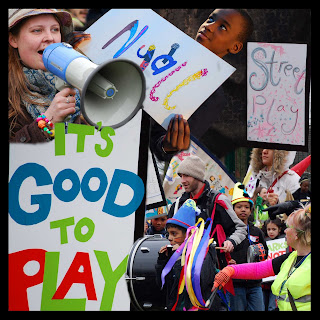 Image 3 - Street Play
Image 3 - Street PlayI found that this image summarised what the documentary is about - the right for children to play. My aim was to show the idea of play and making noise about play. It is also clear that the film was about a parade / rally. However I don't think it is explicit that the images are a compilation of stills from a documentary. Though the theme of children is clearly portrayed.
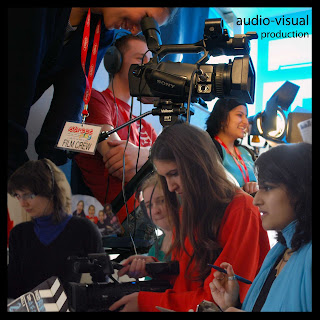 Image 4 - Audio Visual Production
Image 4 - Audio Visual ProductionSPP3: Showreel - The Editing Process
I came across various challenges:
- Making sure the edit was precise - in time with the music. As the beats were defined it was easier to line the cuts in time with the music.
- Engaging the audience - I had to make sure that the videos were not too long or too short so to keep the viewer engaged throughout the 2.30 minutes.
- As well as the videos I had to create titles in Photoshop. With the flexibility of CS3 I was able to import them into Premiere easily. However it was challenging to place them in the right part of the video and ensure the transition was smooth. In order to ensure the consistency of the titles I decided to be precise with how long they were i.e. each transition was timed at exactly 4 seconds.
- To match the music I had decided to use eye-contact as a repetitive feature. This was difficult to time with the music but was very effective as the video and the beat complimented each other.
SPP3: Showreel Content
- Introduction - Who I Am and What I Do
- Street Play - Community Documentary - Producer & Director
- What NTU Can Do For You - Promotional Video - Sound & Camera Assistant
- Holding Pattern - Short Film - Producer & Director
- Indian Women - Canvas Installation - Photographer & Director
- No Knives? Positive Lives! - Youth Documentary - Camera Operator
- Iranian Women - Video Installation - Director
- Sketching in the Nature - Digital Sketchbook - Camera Operator
- Green Kutchh - Environmental Documentary - Producer & Researcher
- Outro - My Contact Detail
SPP3: Assignment 2 - The Submission
Job
- Working Title Films - Action 2009! -
- Freemantle Graduate Scheme -
- BBC Production Trainee -
- Informa Media Academy - Graduate Scheme -
- The Mountbatten Internship - New York Programme -
http://www.mountbatten.org/mipweb.nsf/pages/ny_academic_programme#cert
- MA Global Media -
- MA Film Producing & Business Management -
- MA Arts Management - http://www2.northampton.ac.uk/portal/page/portal/Arts/home/research/pgrad/ma#am
SPP3: Assignment 2
- 4 Job Advertisements
- 1 Job Application (Cover Letter, Content, CV)
- 4 Post-Graduate Course Advertisements
- 1 Post-Graduate Course Application (Cover Letter, Content, CV)
- 1000 Word Rationale About Application Choice
- Exhibition Profile Text & Image
- Exhibition Portfolio Images
- Exhibition Portfolio Showreel
Thursday, March 05, 2009
PRP: Artefact 2 - The Evaluation
I spoke to Meena Patel, a web designer who described the design industry as a split of 50:50 men to women ration. On the other hand she highlighted there is a lack of women developers but the reason for this is dependable on interest. I found this observation interesting and learned that there are more women in web ‘design’ than I had perceived.
I also spoke to the film producer Cassandra Sigsguard. She said there are many women film producers however only 7% of directors in the UK are women. She outlined one of the reasons for a lack of this representation is female interests and lifestyle choices.
I have drawn on a conclusion that the representation of women in Multimedia is weighed according to the sector. Due to the nature of this project I feel it would be more efficient and effective if I concentrated my research on an area that is denser with the problem. I feel that there are less women working as directors and game designers.
For my third artefact I have decided to focus the research on women film directors. I will be using the Birds-eye View Women’s Film Festival as a foundation for this. I can then apply the findings from this to the other areas of multimedia in the broader context. In addition to this I will continue engaging with other women practitioners to enhance my understanding of the project.
Thursday, February 19, 2009
SPP: Exhibition Ideas
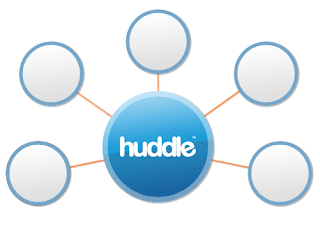
Live Client: Shoot 5 - The Play Parade


Delegation is a quality that comes with hard work and practise. Especially after being used to doing everything yourself, it is something I think I am developing quickly with the scale of this project and find that this is achieving better results. Audio Visual production requires a range of skills and requires the input of various people, creatively and practically. Having to co-ordinate 3 cameras was a useful exercide and I feel more confident in operating the equipment. In addition to this I have been working with the same crew members on a regular basis and we now have an understanding of the ways in which we work. The day brief at the begginning of the shoot was very important to me and I think it was essential to gather the crew and communicate my intentions for the day.
Overall I am pleased with the outcome of today and am looking forward for the next shoots as well as the editing stage.
Live Client: Shoot 3 & 4: An Evaluation
Shoot 3:
Camera: Sherrilyn Lombardelli
Sound: Matthew Robinson
Production Assisstant: Janet Chu
Shoot 4:
Camera 1: Sherrilyn Lombardelli
Sound 1: Diana Sabau
Camera 2: Alex Burton
Sound 2: Matthew Robinson
Production Stills: Tom Edson
We finished both days on schedule and captured the footage that was required. The weather was not pleasent and it was raining on both days. This made me consider the implications of this happening on the day of the Play Parade. It would be very difficult to get the shots I want with bad weather conditions!
Live Client: Shoot 2 - An Evaluation
For this shoot we also had Tome Edson present to take production stills, which is very useful for documenting the process of making the film. I found that as a crew we were very efficient as we were familiar with the location, characters and the style. In addition to this we had formed a working relationship from the shoot before and understood eachother. Furthermore we were more comfortable and confident with the equipment.
Wednesday, February 11, 2009
PRP: Artefact 2 - The Interview Questions
- What was your route into your career?
- What is your educational background? Do you think this has an influence on your career choice?
- What did you find the most challenging when approaching a career in the creative/ technological industry?
- Do you feel there is a shortage of women in the industry?
- Do you feel that women multimedia creators are less well known and recognised? Why?
- What do you think affects or influences the choices women make about their further education and career prospects?
- What are your thoughts about women mentors or role models? Do you think that having a role model could influence and motivate aspiring artists? Do you think there is a lack of this in the UK?
- Did you have a role model, mentor? Did anyone really influence you?
- How do you think the profile of women in multimedia can be increased?
- What factors influence, persuade, inspire and motivate you as a multimedia practitioner?
- Do you think women take on roles that they are expected to by society? On a subconscious level?
- Do you think women create their own barrier into the industry without realising?
PRP: Artefact 2 - The Idea
Considering the time constraints I have decided to approach women working in and around Nottingham so that they are accessible. I may not be able to capture a physical sound recording of the interviews as the interviewees may have other commitments. I aim to at least have a conversation with 5 women from different areas of Multimedia. This conversation may be face-to-face or over the phone.
I am hoping to collect information that is specifically related to the working environment and how this relates to women and multimedia. I feel that practitioners' and students' answers will resemble and differ and various ways.
PRP: An Interesting Statistic
http://grandtextauto.org/2005/06/17/women-games/
This figure has been taken from Aleks Kritoski's paper 'Chicks and Joysticks: an Exploration of Women and Gaming' found at
http://mypages.surrey.ac.uk/psp1ak/publications.htm
Friday, February 06, 2009
Live Client: Shoot 1 - An Evaluation
Location: Playworks
Scenes 3 & 4: Rally Preparation at the Office
Time: 10:30 - 15:00
Crew:
- Director: Bindni Karia
- Camera Operator: Sherrilyn Lombardelli
- Sound Operator: Samantha Kirk
- Production Assistant: Diana Andreea-Sabau
Production for the Street Play documentary began today. I was really nervous yet very excited. We were very punctual and the whole shoot ran very smoothly accodring to the schedule. I found it extremely helpful to have time to test the equipment before we set out. Fortunately the crew arrived earlier than expected which meant that we had time to go through each piece of equipment.
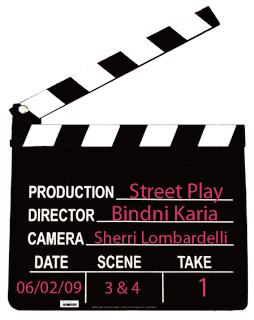
I had decided to have a calm and planned approach to today's shoot and feel this worked very well. For example I spent almost an hour introducing the crew to all the characters at the Playworks office. I also allowed enough time to brief the crew on health and safety and describe exactly what I wanted to achieve from the shoot. This meant that we were all well prepared and less time was wasted in discussion as the shoot was taking place. We took our time to set up the equipment and to ensure that everything was connected correctly. It was very important to double check the format, ratio and mode on the camera.
I found that setting up the sound was the most challenging task. Samantha was very confident with the equipment. I have not been through the footage yet and am worried how the sound has been recorded. As a crew, we worked well as a team and I found that staying calm and focused was extremely beneficial when trying to capture shots on the move. As a bonus we captured everything that I had planned to in the shot list. However I decided not to take the shots outside due to continuity issues with the snowy weather.
Thursday, February 05, 2009
PRP: Artefact 1 - The Evaluation
From the test I discovered that Multimedia seems to be a continuation or follow on from subjects like Art, IT and Media. Students find that confidence is something that holds them back especially from furthering their knowledge in technical areas. They find that technology can be intimidating in certain situations. It was highlighted that men tend to pick things up quicker and this may be due to interest, i.e. women are just not interested in technology. They agreed that to a certain extent it is women’s attitudes and assumptions that sometimes limit them from prospering.
I found that majority of the students feel more comfortable when working around women and they are motivated or inspired by them. However when asked if they were influenced or inspired by a Multimedia practitioner in the industry only 30 % could quote a name.
This raised the question of whether there are women in high status roles within Multimedia and if there are, why are they unheard of or not publicised as much. In order to explore this further I will need to look into how current women practitioners began their career and what, or who supported them. I need to gain a deeper understanding of what women in the industry think of their representation and what can be done in order to improve this. Or what can encourage and inform more women Multimedia students about their particular prospects within the industry.
PRP: Artefact 1: - Quotes from Interviewees
“…how did they get that knowledge and I haven’t?”
“men are always seen as one above us…but I think its getting a lot better”
“we just couldn’t pick it up as quickly…don’t know whether that’s because lads spend more time on the computers as teenagers…”
“…we should learn to have a bit more confidence”
“it is the social aspect of it”
“I think there are a lot less women in the industry because they just don’t find it interesting”
“…learn what you know and improve on that”
“Women now, just generally across the board are becoming a lot more career minded and pushing the boundaries”
“Its interesting, its nice to work with women as well”
“Boys are more drawn to the subjects than girls, I don’t know why…”
“I should maybe know more and be more confident…if I’m with girls I feel more comfortable”
“Not really confident with the ‘tech’ side"
PRP: Artefact 1 - The Presentation

It was an informal presentation and I used a powerpoint presentation to summarise my findings. The presentation prepared me to write the 300 word evaluation in a clear and concise format.
Live Cleint: Testing Equipment

As a result of conversations with academic staff and technicians I have decided to use a portable mixer and connect a radio mic and a K6 mic into two separate mic channels. I will pan each mic hard left and hard right and change the settings on the HD camera so that each mic records onto separate channels. Although this method will result in two mono tracks I will effectively have more control on the levels of the dialogue and the ambience.
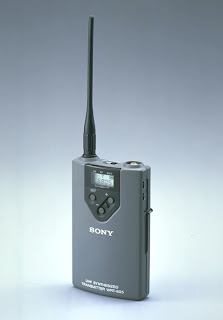
At first i found it extremely difficult and challenging to get my head around the equipment. All the cables and buttons. But I am really glad I had a test today rather than on the day of the shoot. Once I attempted to push the buttons and discover what each function does, I learned that it is quite logical and not as complicated as it looks. I have made noted but I hope that I can put all this into practise for the shoot. I will have far more assistance than I have ever had on a shoot and therefore I will have more support. Fingers crossed....technically!
Hive Creative Business Programme: Communication Workshop
"an appropriate, concise, evocative and authentic piece of communication"

http://www.lcsc.edu/library/ILI/Classes/bus_comm.htm
The delivery was targeted to make us think about communication in Creative Business aspects, however I felt that this clearly and directly linked to the film and documentary film industry. Communication is essential in all parts of the Multimedia Industry. I am acknowledging the importance of it even more as I work with my Live Client.
A pitch should be memorable and you should be able to make a good first impression. Your communication should espouse your values and the values of what you are selling. Your voice must resonate and you must get into tune with your audience in order to effectively communicate to them or even with them. The pitch must be appropriate, as there are different formats for different audiences.

http://www.ntu.ac.uk/hive/index.html
According to a survey carried out in the 1970's at the University of Pennsylvania USA by Dr Ray Birdwhistle communication is divided up into the following sections:
7% = words
38 % = confidence in your voice
55% = physiology - body language
The session ended with an activity that involved creating a brainstorm about myself - what I believe in, what my skills are, how I describe myself. With this we each tried to write a 40 word personal statement. This is what I came up with in the 5 minute time limit:
An effective communicator and a lover of people and places. Combined travel and industry experience to develop skills in detailed organisation. Culturally aware with a positive and collaborative approach to creative challenges. A responsible and professional working attitude with enthusiasm for learning new things.
It is still in the process and I think it still needs improving. Overall I thought the session was very motivational and will definitely help me in my projects.
Wednesday, February 04, 2009
Film Review: Slumdog Millionnaire
I felt that the film was shot adventurously and the young actors were amazing. They were actually co directed by Loveleen Tandon. In addition to this I think the sound was one of the most influential aspects in creating the atmosphere, pace and anticipation in the film. A R Rehman has a distinctive style and I have always enjoyed his music. I particularly liked how various genres of music were used to add to the story. Such as the homage to classic Bollywood songs and also the remixes of EMI's songs. The lyrics emphasised and complimented what was happening visually on the screen.
In particular, I could relate to the scene where the young boys are making a living by selling products illegally on the public trains. I experienced this first hand whilst travelling on the trains in India and felt that the song that accompanied this scene was really well placed.
Although the film's story was predictable I think it was a great effort. I thought the sound was the best aspect of the film.
PRP: Artefact 1 - The Test
I found it interesting that each interviewee had drawn upon personal experiences to answer the questions however their response was similar in many ways. I am currently reflecting on the interviews and forming a method of representing the results as they are compiled.
As mentioned before, my aim is to find a common thread or a link to lead me to my next artefact.
Live Client: The Big Crew Meeting
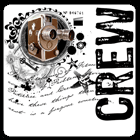
I have scheduled a pre-production meeting which is less technical and more of a 'prep-talk' before production begins. My aim is to increase enthusiasm between all the contributors and create a sense of passion for the film. I do not want them to think that they are working on my project but rather we are working on this project. Hopefully it will go well, I am quite nervous about it but also excited.
Live Client: Pre-production
- Location Release forms
- Shot lists
- Call Sheets
- Risk Assessments
- Floor Plans
- Talent Release forms
- Book and take out equipment (as well as confirm how to use some of it)

SPP: Graduate Job Application
www.informa.com
The 12 month programme would be based in London and would cover experience in the following areas:
Editorial
Events Research
Reports
Data Forecasting
Although this is not directly linked to Audio-Visual Production I think that the skills I have gained on the Multimedia course can be effectively applied to this job role. After the 12 months I feel that the experience will allow me to develop skills that would allow me to pursue a career in Producing & Directing. The programme will give me awareness in an international marketplace and I will be able to learn new managerial and transferable skills.
The application and interview process is long, I am looking forward to see if my application progresses to the next stage.
Tuesday, January 27, 2009
PRP: Artefact 1 - The Interview Questions
- Why did you choose to study Multimedia? Did you always think you would? What kind of subjects did you study at school and college?
- What considerations, thoughts and concerns did you have about studying Multimedia? Did you think it would be technical, creative or both? Did you ever consider it a boy's subject?
- Do you think there are well known and recognised women in the Multimedia Industry? Do you know their names? Are they established?
- I have seen various women's' names in credits etc however they don't seem to be as publicised. All the big names tend to be men to me, how do you feel about this?
- Do you idealise a woman artist / creator, do you look up to anyone as a role model? Has anyone's work influenced you so much to convince you to enter the industry?
- Do you feel intimidated when you are around technology? Does this change when there are more or less men around you?
- Do you feel challenged by technology?
- There have always been issues and debates about women in Science Engineering and Technology (SET). What do you have to say about that statement?
- It's actually women who take on roles that they are expected to. They stop themselves from climbing further up the ladder. It's their attitude and assumptions...not the society. What do you have to say about these statements? Do you think they're true?
- What profession do you see yourself in once you graduate? a) See yourself? b) Would like to be in? Are A and B the same?
- If A and B are different why do you think this is? The desirable seems to be unachievable? Do you have a back-up profession, why?
- Do you feel like you fulfil certain roles or are better at certain roles because you're expected to?
- Do you think women always deal with particular subjects or follow a certain style for example activism and feminism?
PRP: Artefact 1 - The Idea
My aim is to achieve a deeper and varied understanding of women's thoughts and opinions of their representation in the industry as artists. I intend to have a dialogue with each interviewee and I expect all the answers to be different. Although my objective is to ask particular open ended questions, I intend to leave the conversation open to changes and expect to ask questions that have been lead to and provoked by their answers.
From the series of interviews I am expecting to find a 'thread' or a 'link' that connects each answer. This will lead me to the next artefact. I am expecting a common occurring theme in the answers although they will be based on personal experiences.
Research Via Practise - The Question
For my artefacts I will be researching:
How have successful women multimedia artists managed to enter the industry and what provoked them to avoid or overcome the limitation commonly characterised as ‘the glass ceiling’?
Client Project - Gantt Chart
- Pre-production = December 08 & January 09
- Production = February 09
- Post-Production = March 09
- Contingency = April (week 1)
- Distribution & Evaluation = April (weeks 2-4)
- Screenings & Publicity = May 09
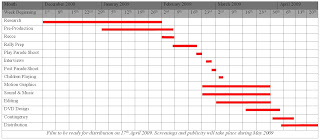
Client Proposal Presentation

- Structure: define further in terms of what each section will represent. Instead of beginning, middle and end use establish subject and problem, climax, find solution, conclusion (what happens now) and resolution.
- Pilot was clear and concise, showed the subject and style well. Last shot of the pilot however was not good and should not have been used. The pilot represents your skills and ability and should therefore not include anything that is shot poorly.
- Ensure clarity of exact shots for the production crew.
- In the pilot some of the shots were not technically correct. Make sure interviews are done at eye-level and framed correctly.
- Ensure same aspect ratio is used for all filming. I had captured some of the footage in 4:3 and rectified this after handing in the proposal. I showed the corrected version for my presentation.
- Advised to use children as a means of telling the story, keep the theme running visually - giving children a voice - don't get carried away allowing adults to talk about play expectations and experiences.
Client Proposal - The Final Draft
- Background & Introduction
- Synopsis
- Treatment
- Characters
- Locations
- Style & Format
- Structure
- Production Plan
- Budget
- Audience & Distribution
- Production Personnel
- Appendices
- A: Playworks Newsletter
- B: Play Parade flyer
- C: Work in progress DVD
- D: Location Photos
- E: Visualisations
- F: Script
- G: Scene Summary
- H: Detailed Shooting Schedule
- I: Detailed Budget
- J: Production Personnel Details
- K: Management & Legalities
- Bibliography
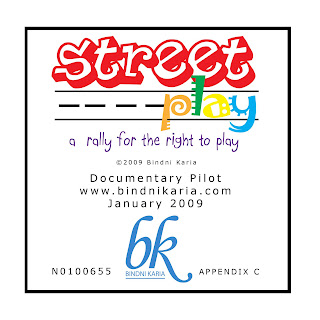 Writing the actual proposal was a lot easier than I had expected. Although I think this was only because I had done a lot of background research and 'preparation' for the proposal (for example the proposal organiser in Michael Rabiger's book).
Writing the actual proposal was a lot easier than I had expected. Although I think this was only because I had done a lot of background research and 'preparation' for the proposal (for example the proposal organiser in Michael Rabiger's book).I found it very difficult to produce the budget as I lack skills on Excel, which is not good considering I want to go into Producing. I found it interesting however to find out professional rates for crew staff and prices for hiring equipment. In total the foretasted budget came to a grand total of £85,000. This is the cost for the entire production including salary, insurance, staff, pre-production, production, post-production and distribution. One of the largest cost I found was my salary (if the documentary was being produced commercially for broadcast).
Producing a detailed schedule was not only time-consuming but also difficult as certain aspects had to be decided. For example I used the Production Management Software Celtx to write a script, for which I needed to know precise details. The script then acted as a backbone to create a detailed schedule, scene summary, catalogue etc. Once all the main details were inserted the software efficiently produced reports, this indirectly saves time for the rest of the pre-production phase.
Ultimately the appendix items made up most of the proposal and supported the main written section. I enjoyed producing the proposal and it gave me an insight into aspects I wouldn't have otherwise thought of. Although the proposal had been handed in there is still a great deal of pre-production to do:
- Detailed call sheets for crew
- Recce of all locations
- Risk Assessment for all locations
- Obtain talent and location release plans
- Shot Lists
- Equipment Lists
- Production Briefing Meetings



